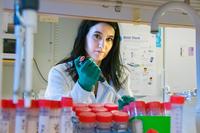Structure-function of transmembrane protein complexes
Short description
The human body is made up by cells whose integrity is protected by an outer lipid layer called a membrane. Within this membrane, a number of proteins capable of relaying signals or transporting metabolites are found (membrane proteins). There are thousands of membrane proteins in the body, and many of them interact with one another to create complexes with altered function compared to their non-complexed counterparts. These complexes are poorly understood, and Linda Johansson's research aims to find the molecular basis for modulation of cellular response, through the use of sophisticated, cutting-edge methods including X-ray diffraction and cryo-electron microscopy.
In the human body, integral membrane proteins carry out a variety of essential tasks including relaying signals from the outside environment into the cell, transporting nutrients, metabolites or ions or performing enzymatic reactions. These proteins constitute about 30 percent of all drug targets and high-resolution structures of these proteins are essential for design and optimization of novel therapeutics.
Membrane proteins often associate with other proteins to alter, enhance or modulate their intrinsic function. We study transmembrane complexes, which are entities consisting of two or more transmembrane proteins, either homo- or heteromeric, with properties significantly different from their monomeric counterparts. We focus on clinically relevant proteins in health and disease, including G protein-coupled receptors and metabolite transporters. Both these classes of membrane proteins are capable of forming oligomeric transmembrane complexes, however their three-dimensional complex structures, interaction partners and ligand binding capabilities remain unknown.
We combine cutting edge structural methods including single-particle cryo-EM and serial femtosecond crystallography, with signaling/ligand binding and transport assays along with electrophysiology, dynamics and in silico modelling to approximate an understanding of the occurrences within the native cell. A major component of our research involves the creation of cell-mimicking environments for structural determination of transmembrane complexes as these are dependent on particular lipid composition environments. Some of our resources are also dedicated towards finding and testing various high-affinity binders for subsequent drug discovery efforts for these transmembrane complexes.
Our laboratory employs a highly collaborative approach, and includes partners both in the Gothenburg area as well as national and international research laboratories and industrial partners. Additionally, our data collection efforts are performed at X-ray/XFEL and cryo-EM sources around the world.
Our goal is to take the first steps towards a complete understanding of the mechanisms governing signaling and transport events within the cell. While this is a daunting task, we aspire to approximate cellular environments for functional studies and structural determination efforts.

Linda Johansson
Principal Investigator
Affiliation:
Department of Medical Biochemistry and Cell Biology,
Institute of Biomedicine
Group members
Petra Båth
Simon Lind
Sarah Al Hamoud Al Asswad
Ayaan Abdi Ali
Damasus Okeke
Daniel Hedberg
Negar Ayoubzadeh